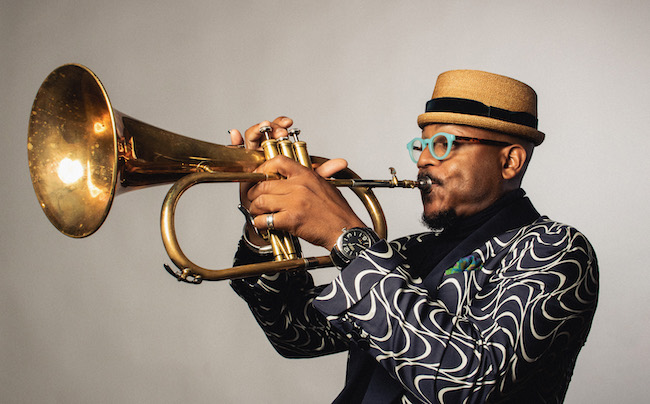Oct 28, 2025 10:47 AM
In Memoriam: Jack DeJohnette, 1942–2025
Jack DeJohnette, a bold and resourceful drummer and NEA Jazz Master who forged a unique vocabulary on the kit over his…

Etienne Charles and his Creole Orchestra drew liberally on sources beyond the Trinidad native’s comfort zone.
(Photo: Luigi Creese)On Oct. 8, 2022, Etienne Charles reopened Lincoln Center’s newly renovated David Geffen Hall with San Juan Hill, a lacerating new work he had written for the New York Philharmonic. The composition, a complex depiction of a culturally rich neighborhood displaced by a new cultural landmark, brilliantly integrated elements of Afro-Caribbean music with stride, swing, disco, funk — and more.
This past June 15, Charles was back on familiar ground, this time leading an 18-piece big band, Creole Orchestra, at Jazz at Lincoln Center’s Dizzy’s Club. The music, like Charles’ philharmonic score, was infused with the spirit of the Caribbean. And, like the earlier work, it also drew liberally on sources beyond the Trinidad native’s comfort zone.
Decked out in a white suit set off by a blinding print shirt, aquamarine shoes and no socks, Charles, playing to a packed house, fashioned a rhythmically diverse, harmonically lavish collection of tunes that, taken together with San Juan Hill, burnished his reputation as one of New York’s most flamboyant, resourceful and deeply swinging storytellers for large ensembles.
To be sure, Charles very much intended to live up to the band’s Creole moniker. The mere presence of a steel pan set the ensemble apart from most big bands. In the hands of Andrew White, the pan played a substantial role both out front and as an inner voice, adding a singular dimension to the texture and harmonic color of Charles’ multilayered arrangements.
The pan figured most prominently in the opening number, “Douens,” a Charles original inspired by the Trinidadian legend of faceless, forest-dwelling creatures who were of questionable intent but strangely sympathetic, owing to their origins as unbaptized children. Capturing this complexity, Charles built a narrative on a deceptively jaunty calypso beat atop which White, by turns playful and doleful, set the stage for solos by Charles on trumpet, Godwin Louis on soprano saxophone and, in a particularly pointed mambo-inflected turn, Axel Tosca on piano. Children of the Caribbean themselves, the three soloists authoritatively held up a mirror to this corner of the Creole soul.
Likewise, Jamaica native Monty Alexander’s “Think Twice” reflected that soul, though it found expression in the realm of reggae. A spiky contrafact on Cole Porter’s “Love For Sale,” the tune, in Charles’ telling, was a cautionary tale, its title a warning to those who would engage in the sale of love. Wisely, Charles recruited two women to be the primary explorers of this touchy terrain.
Tenor saxophonist Jordan Pettay offered long passages of languid straight eighth notes punctuated by well-placed twists and turns. Alighting on one — an upper-register quote of Porter’s melody — she elicited an apparently spontaneous “Play it!” from a multitasking Charles, who was manning the congas as he led the band. Pettay’s account played as sardonic observation.
Trumpeter Summer Camargo proffered a blistering rejoinder, ranging, in a no-holds-barred series of choruses, from piercing highs to growling lows that left little doubt about where she stood. It then fell to bassist Brandon Rose to cool things down with a fluidly executed, purposefully detached take before Charles lit the flame again with a brassy finish.
Gumbo for beginners this was not. But guitarist Alex Wintz’s accent on the offbeat never wavered and, tempered by the flawless balancing of section players — slightly sweet on the saxes’ part, slyly unsavory on the trumpets’ — even the spiciest commentary went down easily.
Just as Charles had seemed to settle in comfortably on Caribbean turf, he took a sharp detour into hard-bop with Joe Henderson’s “A Shade Of Jade.” Powered by Rashaan Salaam’s roaring trombone, the band went into overdrive — so much so that, when Charles suddenly downshifted, taking it way down with Henry Mancini’s “Lujon,” the audience seemed to exhale.
A slowly pulsating bolero, “Lujon” resonated powerfully, the audience drawn in by the luxuriant blend of clarinets and flutes — and, most especially, by the bass clarinet solos of Paul Nedzela, who established the reflective tone, and John Ellis, who elaborated on it. Charles, maintaining the mood in the lone airing of his flugelhorn, evoked the mellow trumpeters on Mancini and Johnny Mandel soundtracks.
Then, as suddenly as Charles had taken it down, he cranked it up again with Bell Biv DeVoe’s hybrid “new jack swing” classic “Poison.” High-voltage solos smoked out Rose from behind his bass to offer a hyperkinetic rap. Charles gamely grabbed the bass and dug into five notes on a loop. The band, on cue, led the crowd in shouts of “poison!” And everyone went home on a high. DB

Jack DeJohnette boasted a musical resume that was as long as it was fearsome.
Oct 28, 2025 10:47 AM
Jack DeJohnette, a bold and resourceful drummer and NEA Jazz Master who forged a unique vocabulary on the kit over his…

Goodwin was one of the most acclaimed, successful and influential jazz musicians of his generation.
Dec 9, 2025 12:28 PM
Gordon Goodwin, an award-winning saxophonist, pianist, bandleader, composer and arranger, died Dec. 8 in Los Angeles.…

Flea has returned to his first instrument — the trumpet — and assembled a dream band of jazz musicians to record a new album.
Dec 2, 2025 2:01 AM
After a nearly five-decade career as one of his generation’s defining rock bassists, Flea has returned to his first…

Nov 13, 2025 10:00 AM
For results of DownBeat’s 90th Annual Readers Poll, complete with feature articles from our December 2025 issue,…

To see the complete list of nominations for the 2026 Grammy Awards, go to grammy.com.
Nov 11, 2025 12:35 PM
The nominations for the 2026 Grammy Awards are in, with plenty to smile about for the worlds of jazz, blues and beyond.…








